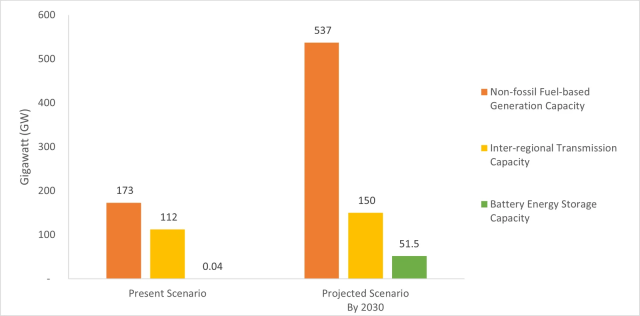India’s Planned RE Capacity of 537 GW by 2030 to Require US$30 billion of New Transmission Systems
On 7th December 2022, the Ministry of Power and New & Renewable Energy (MNRE) launched a plan to develop a transmission system for integrating 537 GW of renewable energy (RE) capacity by 2030. Achieving this target will require a significant amount of renewable energy investment in India. This plan is a major stepping stone towards India’s climate commitment of achieving 50% of cumulative installed capacity by 2030 from non-fossil fuel-based sources.

As on 30st November 2022, the cumulative installed capacity in the country was 409 GW.[1] Of which, 42% (173 GW) came from non-fossil fuel-based sources (including nuclear and large hydro). The Government of India envisages the non-fossil fuel-based installed capacity to grow to 500 GW by 2030. This translates to 40-50 GW of capacity addition (of non-fossil fuel type) in the next 7-8 years.
To foster non-fossil fuel- or RE-based capacity growth of such magnitude, it is critical to have/develop a robust transmission system so that the power from the prospective RE capacity could be evacuated to the load centres. Further, with the gestation period of wind and solar power-based generation projects being much less than the gestation period of associated transmission system, a committee led by the Central Electricity Authority (CEA) chalked out the transmission system plan to accommodate the planned RE capacity addition.
- As per the committee, the planned transmission system will require a renewable energy investment in India of INR 2.44 lakh crore (US$30 billion).
- This would entail additional transmission lines of a total length of 50,890 circuit kilometre (ckm). Further, the inter-regional capacity will increase to about 150 GW by 2030 from 112 GW at present.
- The transmission plan also includes transmission system required for evacuation of 10 GW off-shore wind located in Gujarat and Tamil Nadu at an estimated cost of INR 0.28 lakh crore (US$3.4 billion).
- Considering the limited diurnal availability of RE-based generation, the plan also envisages installation of Battery Energy Storage Capacity of the order of 51.5 GW by 2030 to provide round-the-clock power to end-consumers.
Figure 1: RE Generation, Inter-regional Transmission and Battery Storage – 2030 India Capacity Projections

Source: Central Electricity Authority, JMK Research
The plan has identified major upcoming non-fossil fuel-based generation centres in the country based on which transmission systems have been planned. This include:
- Fatehgarh, Bhadla, Bikaner in Rajasthan
- Khavda in Gujarat, Anantapur
- Kurnool RE Zones in Andhra Pradesh
- offshore wind potentials in Tamil Nadu and Gujarat
- RE park in Ladakh etc.
Enhancing the existing transmission infrastructure is unequivocally important for enabling India’s RE transition and in achieving the country’s climate goals. A robust transmission network would also be a significant catalyst for up-and-coming and emerging markets including Green Term Ahead Market (GTAM), ISTS open access and Virtual Power Purchase Agreement (VPPA).
[1] CEA
